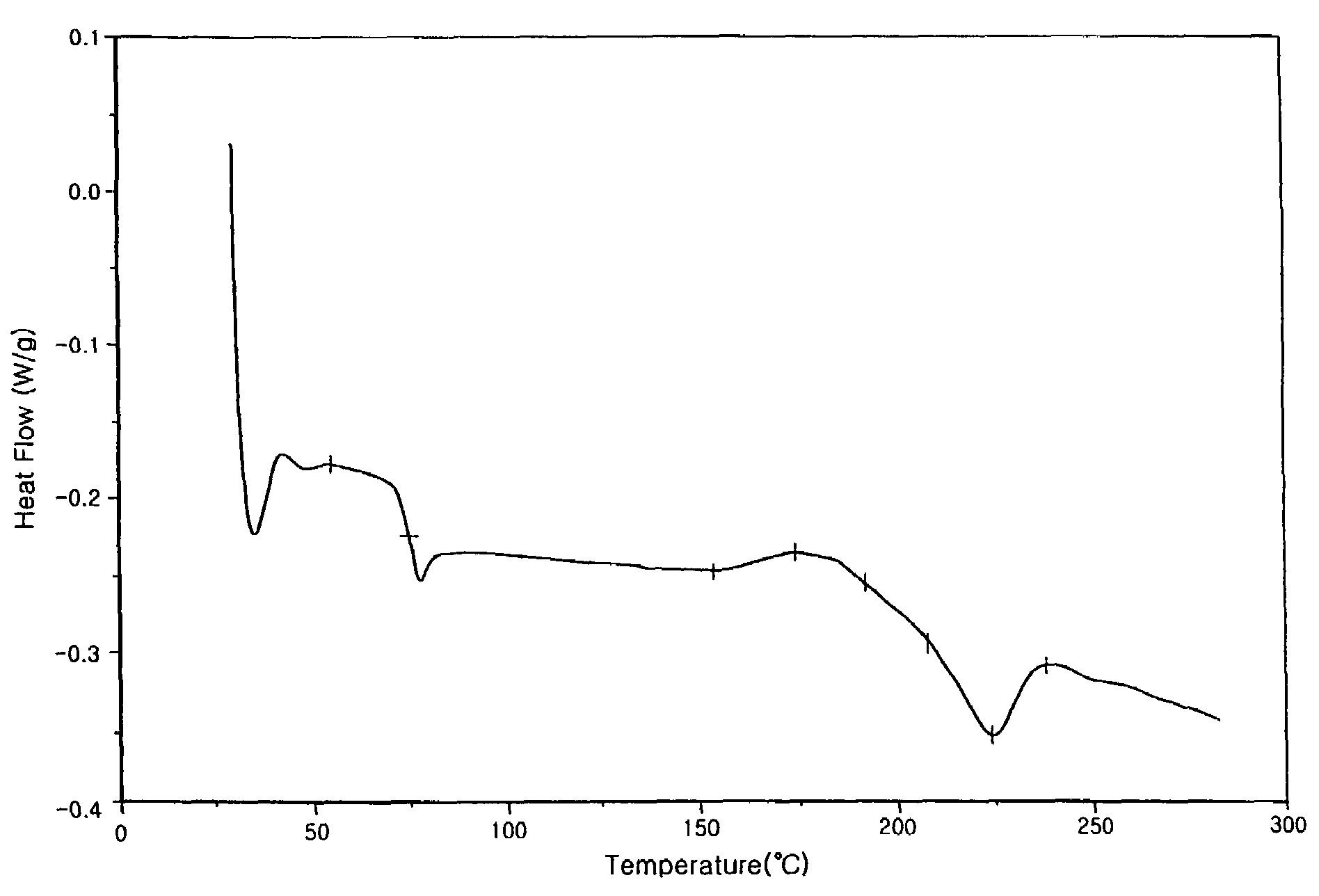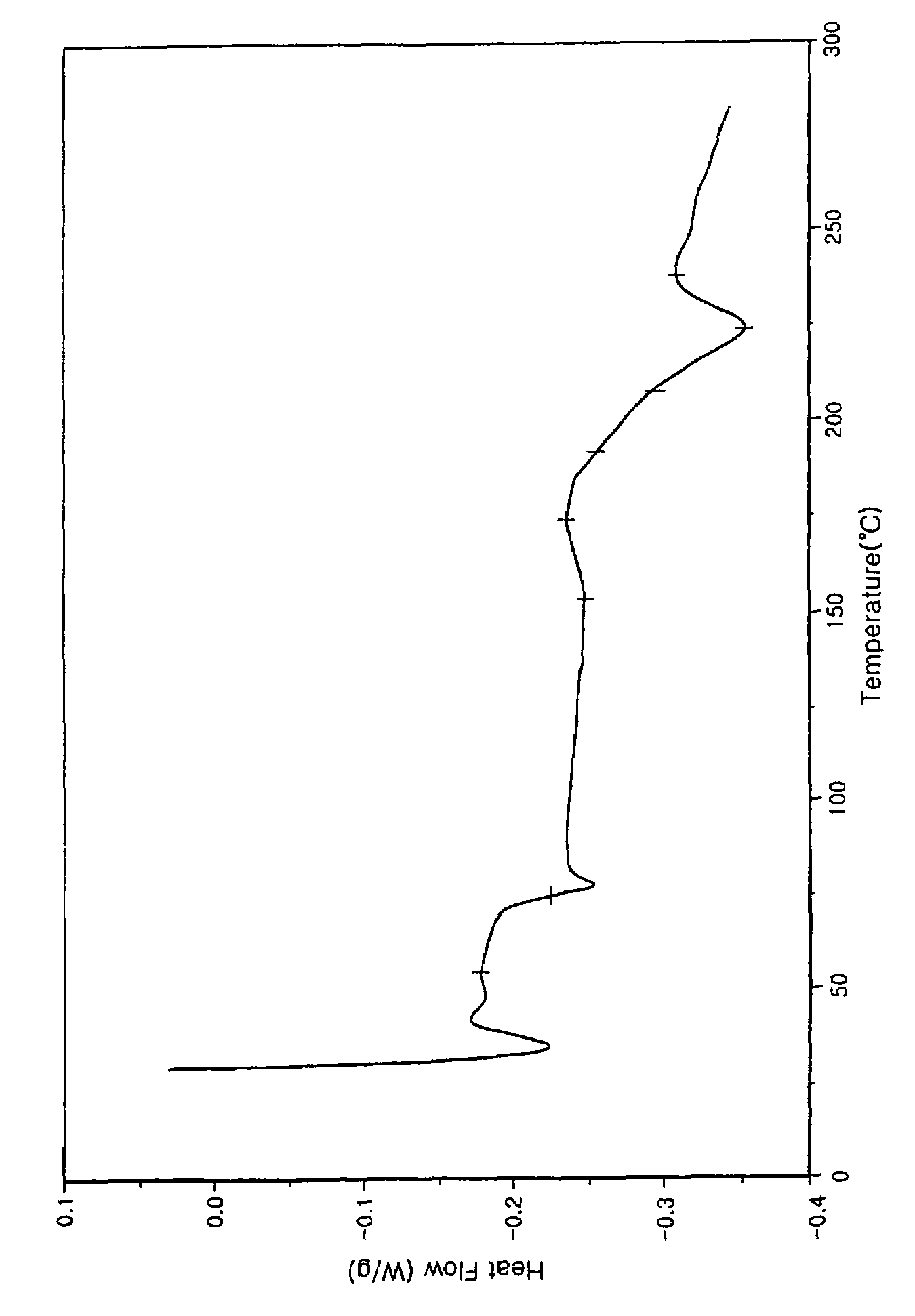Heat-shrinkable polyester film having excellent crystallinity
a polyester film, excellent crystallinity technology, applied in the direction of filament/thread forming, transportation and packaging, animal husbandry, etc., can solve the problems of poor printability and storage, insufficient heat resistance, melt or tear, etc., and achieve the effect of reducing the shrinkage ra
- Summary
- Abstract
- Description
- Claims
- Application Information
AI Technical Summary
Benefits of technology
Problems solved by technology
Method used
Image
Examples
synthetic example 1
[0039]2,000 kg of dimethylterephthalate and 1,278 kg of ethylene glycol were introduced into a reaction tube, and then manganese acetate was added at the amount of 0.08 wt % relative to the amount of dimethylterephthalate. The mixture was heated slowly to 240° C. with the removal of generated methanol. At the end of the ester interchange reaction, trimethyl phosphate as a thermal stabilizer was added at the amount of 0.03 wt % relative to the amount of dimethylterephthalate. After 5 minutes, antimony trioxide was added at the amount of 0.03 wt % relative to the amount of dimethylterephthalate and then continued to stir for 5 minutes. After the oligomeric mixture was transferred to another reactor equipped with a vacuum system, its temperature was elevated from 250° C. to 280° C., thereby obtaining polyethylene terephthalate (PET) having an intrinsic viscosity of 0.6 dl / g.
synthetic example 2
[0040]2,000 kg of dimethylterephthalate and 1,568 kg of 1,3-propanediol were introduced into a reaction tube, and then manganese acetate was added at the amount of 0.08 wt % relative to the amount of dimethylterephthalate. The mixture was heated slowly to 240° C. with the removal of generated methanol. At the end of the ester interchange reaction, trimethyl phosphate as a thermal stabilizer was added at the amount of 0.03 wt % relative to the amount of dimethylterephthalate. After 5 minutes, antimony trioxide was added at the amount of 0.04 wt % relative to the amount of dimethylterephthalate, and after 10 minutes, tetrabutyltitanate was added at the amount of 0.005 wt % relative to the amount of dimethylterephthalate and then the mixture was continued to stir for 5 minutes. After the oligomeric mixture was transferred to another reactor equipped with a vacuum system, its temperature was elevated from 250° C. to 280° C., thereby obtaining polyethylene terephthalate (PTT) having an i...
synthetic example 3
[0041]2,000 kg of dimethylterephthalate, 1,856 kg of 1,4-butanediol, 750 g of tetrabutyltitanate, 150 g of hydrated monobutyltin oxide, 2,500 g of sodium 2,2′-methylenebis-(4,6-di-tert-butylphenyl)phosphate and 1,250 g of Iganox 1010 (Ciba-Geigy) were introduced into a reaction tube. The mixture was heated slowly to 240° C. with the removal of generated methanol. At the end of the ester interchange reaction, 225 g of lithium acetate and 750 g of tetrabutyltitanate were added. After the mixture was transferred to another reactor equipped with a vacuum system, its temperature was elevated from 250° C. to 280° C., thereby obtaining polybutylene terephthalate (PBT) having an intrinsic viscosity of 0.83 dl / g.
PUM
| Property | Measurement | Unit |
|---|---|---|
| crystallization temperature | aaaaa | aaaaa |
| heat shrinkage | aaaaa | aaaaa |
| crystallization temperature | aaaaa | aaaaa |
Abstract
Description
Claims
Application Information
 Login to View More
Login to View More - R&D
- Intellectual Property
- Life Sciences
- Materials
- Tech Scout
- Unparalleled Data Quality
- Higher Quality Content
- 60% Fewer Hallucinations
Browse by: Latest US Patents, China's latest patents, Technical Efficacy Thesaurus, Application Domain, Technology Topic, Popular Technical Reports.
© 2025 PatSnap. All rights reserved.Legal|Privacy policy|Modern Slavery Act Transparency Statement|Sitemap|About US| Contact US: help@patsnap.com



